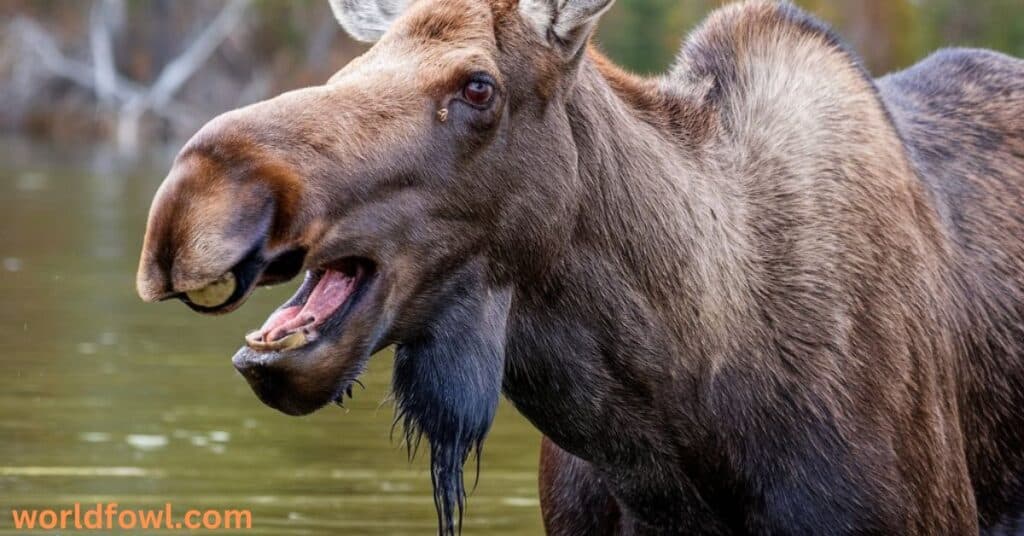Moose are some of the most awe-inspiring animals in the world. Their immense size, impressive antlers, and graceful yet powerful movements make them a fascinating subject for wildlife enthusiasts. But many wonder, do moose attack humans? Despite their somewhat intimidating appearance, moose are not inherently aggressive animals. They are, however, wild creatures, and like all wild animals, their behavior can sometimes be unpredictable, especially when they feel threatened or provoked. Understanding moose behavior, the triggers for moose aggression, and how to avoid dangerous encounters is essential for anyone who spends time in moose habitats.
In this deep dive, we’ll explore everything you need to know about moose attacks, their physical threats, what causes moose aggression, and, most importantly, how you can stay safe if you find yourself in moose territory.
What Are Moose? Understanding These Majestic Creatures

Before diving into moose attacks and moose aggression, it’s essential to understand the characteristics of the animals themselves. Moose are the largest members of the deer family (Cervidae), and their physical traits play a significant role in their behavior.
Physical Characteristics of Moose
Moose are massive animals. Bulls (male moose) can weigh up to 1,500 pounds, with some of the largest bulls reaching over 7 feet tall when measured at the shoulder. Cows (female moose) are smaller, weighing between 800 and 1,100 pounds. Despite their bulk, moose are surprisingly agile creatures. They can run at speeds of up to 35 miles per hour and swim gracefully across lakes, using their long legs and buoyant bodies to navigate through water with ease.
Key features of moose include:
- Antlers: Male moose grow large, broad antlers that can span up to 6 feet in width. These antlers are shed and regrown each year, with the process being most dramatic during the rut season (mating season). Female moose do not grow antlers.
- Coat: Moose have a dense, insulating coat designed to protect them from cold climates. Their fur is darker in the winter and lighter in the summer. Moose are also well adapted to cold environments due to their thick fur and large size.
- Hooves: Moose have large, broad hooves designed for traversing snow and soft, swampy ground. Their hooves are well-suited to navigating the wetlands and forests where they live.
These physical traits help explain the moose behavior observed in the wild. Their strength, speed, and resilience are essential to their survival, but they can also be factors that make them dangerous if they feel threatened.
Habitat and Distribution of Moose
Moose are found in North America, Scandinavia, and Russia, with distinct populations in each region. In North America, they are most commonly found in northern Canada, Alaska, and parts of the northern U.S., especially in states like Maine, Montana, and Minnesota. Moose prefer remote, forested areas near wetlands, lakes, and rivers where they can find their preferred foods, such as aquatic plants, twigs, and bark.
Key aspects of their habitat include:
- Moose Habitat: Moose thrive in environments with dense forests, wetlands, and colder climates. They are particularly drawn to swampy areas, where they can find water and browse on aquatic vegetation.
- Moose Distribution: While moose are widely distributed across these regions, their populations tend to be concentrated in areas with sufficient food, space, and shelter. In the U.S., moose populations are more prominent in states like Alaska, Maine, and Minnesota, but they have also been reported in parts of Wyoming, Montana, and the northern Rocky Mountains.
Understanding moose habitat and distribution is key when discussing moose encounters. These areas are often remote, and people who live or recreate in these regions may be more likely to come across these majestic animals.
See Also : Will Cattle Attack Humans? Identifying the Risks!
Why Do Moose Attack Humans? Breaking Down the Causes

The question “Do moose attack humans?” often arises when people hear about a moose encounter gone wrong. In reality, moose are generally not aggressive toward humans unless provoked or threatened. However, certain circumstances can make moose more likely to attack in self-defense or due to heightened aggression. These factors are mainly related to the moose’s natural instincts for defense, mating, and protecting their young.
Defensive Behavior
Like all wild animals, moose have a natural instinct to protect themselves from perceived threats. When a moose feels cornered or threatened, it will react in self-defense. Moose behavior tends to be calm when left undisturbed, but they can quickly become defensive if they feel their personal space is violated.
- Signs of aggression: A moose that is about to become aggressive will often give clear warning signs. These may include:
- Pinned ears: When a moose flattens its ears against its head, this is a clear indication that it feels threatened.
- Tense posture: A moose may stand still and stare at you, with its body stiffening as it prepares to charge.
- Snorting or vocalizing: Some moose will make snorting sounds when threatened or agitated.
It’s important to understand these warning signs and take them seriously. If you encounter a moose and it exhibits these behaviors, back away slowly and avoid making sudden movements.
Mating Season Aggression
One of the most dangerous times to encounter a moose is during the rut season (mating season), which typically occurs in the fall. During this time, male moose (bulls) are highly territorial and focused on competing for mates. This hormonal surge makes bulls more aggressive and more likely to act out against perceived threats, including humans.
- Aggression triggers: During the rut season, male moose are more likely to challenge anything that they perceive as a rival. This could include other male moose, but in some cases, they may attack humans or other animals in their path.
- Behavior of bulls: Bulls during the mating season may be more prone to charging or becoming defensive when they feel their territory is threatened. They may see a human as an intruder in their space, and a moose charge during this time can be a serious threat.
Calf Protection
Moose mothers (cows) are extremely protective of their calves, especially in the early stages after birth. If a cow feels that her calf is in danger, she will not hesitate to attack to protect it. Calf protection is one of the primary reasons for moose aggression toward humans.
- Motherly instincts: A mother moose will charge if she feels her calf is threatened by a human or another animal. This is particularly dangerous when the calf is young and vulnerable, as the mother’s primary focus is its survival.
- Signs of a protective mother: If you encounter a moose with a calf, always give them plenty of space. The cow may be more likely to perceive your presence as a threat if you get too close.
Human Actions and Habituation
Human behavior also plays a significant role in moose aggression. Moose attacks are more likely when humans inadvertently provoke the animal through their actions. For example, approaching a moose too closely or startling it can result in a moose charge.
- Feeding moose: Feeding wild animals, including moose, is a dangerous practice. Moose that are fed by humans lose their natural fear and may begin to associate humans with food. This can lead to moose encounters becoming more frequent, and in some cases, more aggressive.
- Habituation: When moose become accustomed to human presence, they may lose their instinct to avoid people. This can increase the likelihood of close encounters, which may escalate into an attack if the animal feels threatened.
See Also : Do Bulls Attack Humans? Key Reasons!
Are Moose Attacks Dangerous?

Moose attacks are rare, but when they do occur, the consequences can be serious due to the moose’s size and strength. Moose are not just big; they are incredibly powerful animals capable of causing significant harm if they choose to engage in aggressive behavior.
Physical Threats of Moose Attacks
Moose have powerful legs and hooves that they use to defend themselves. When a moose feels threatened, it may kick, charge, or use its massive size to knock down its aggressor.
- Kicks: A moose can deliver powerful kicks that could break bones or cause internal injuries. These kicks can be especially dangerous if a person is knocked down and unable to get up.
- Charging behavior: If a moose charges, it can use its body weight and speed to knock a person over. The impact of a moose charging at full speed could be devastating, especially in remote areas where help may be far away.
- Antlers: In rare cases, particularly during the rut season, a male moose may use its antlers to defend itself or attack. The size and sharpness of moose antlers can cause deep cuts or puncture wounds.
Statistics on Moose Attacks
According to wildlife statistics, moose attacks on humans are not common but are still a recognized risk, particularly in areas where moose populations are dense.
- In North America, there are around 10 to 20 recorded moose attacks on humans each year.
- The number of fatal attacks is much lower, but serious injuries can occur. Many of these attacks happen when a moose feels cornered, threatened, or when a person gets too close to a mother with her calf.
Can Moose Attacks Be Fatal?
Although rare, fatal moose attacks can happen. The physical threats posed by a charging moose or a moose using its hooves or antlers are significant enough to cause death in certain circumstances.
- Fatalities: Fatalities are rare but have occurred, particularly in remote wilderness areas where help is not immediately available.
- Severe injuries: Non-fatal injuries can still be very serious, with broken bones, internal injuries, and head trauma being common outcomes of a moose charge.
See Also : Do Baboons Attack Humans? Living in Fear!
How to Avoid Moose Attacks: Safety Tips

The best way to avoid a moose attack is to understand moose behavior and know how to act if you encounter one in the wild.
Recognize Warning Signs of Aggression
The first step to moose safety is to recognize moose aggression triggers. If a moose shows any signs of discomfort or aggression, back away slowly.
- Warning signs of aggression: Pinned ears, raised hackles, intense staring, or snorting are all signs that a moose may be ready to charge.
- Give space: Always keep a safe distance (at least 100 feet) from any moose, particularly if it’s a cow with a calf or during the rut season.
What to Do if a Moose Charges
If a moose charges, it’s important to stay calm and act quickly.
- Do not run: Running may provoke the moose to chase. Stay still, and if possible, get behind a large object such as a tree or rock for protection.
- Move slowly: If there is no cover, back away slowly without turning your back on the moose.
- Find shelter: If you’re near a vehicle or building, seek shelter immediately.
Avoiding Moose Encounters
- Stay in groups: Moose are less likely to feel threatened by groups of people, reducing the risk of a moose attack.
- Make noise: When hiking, make noise so that you don’t accidentally surprise a moose. However, avoid screaming or sudden movements that may startle the animal.
- Stay on trails: Stick to marked trails to minimize your chances of encountering a moose in dense areas.
Final Verdict: Do Moose Attack Humans?
So, do moose attack humans? The answer is yes, but only under certain conditions. While moose are generally peaceful creatures, they will become aggressive when provoked, especially during the rut season or if they are protecting their calves.
However, the likelihood of a moose attack is low if you follow proper wildlife safety guidelines. Respect the animals, keep your distance, and avoid behavior that could provoke aggression. By understanding moose behavior and recognizing the warning signs, you can reduce the risk of encountering an aggressive moose and ensure that your adventures in the wild remain safe.
See Also : Do Pandas Attack Humans? Cuddly Yet Deadly?
FAQs: Answering Your Burning Questions About Moose Attacks
Moose aggression peaks during the mating season (rut), when bulls are more territorial and protective. Calf-rearing season also triggers heightened aggression.
How common are moose attacks on humans?
While moose attacks are rare, they do happen, with approximately 10 to 20 incidents reported annually in North America.
What should you do if a moose charges at you?
Stay calm, find shelter, and back away slowly. Do not run.
Can moose attacks be fatal?
Yes, in rare cases, moose attacks can be fatal, particularly if a person is knocked over and trampled.
Are moose more aggressive than other large animals?
Moose can be more aggressive than other large animals, particularly during the rut season and when protecting their calves.
Why are moose more dangerous during certain seasons?
Moose aggression peaks during the mating season (rut), when bulls are more territorial and protective. Calf-rearing season also triggers heightened aggression.
Conclusion: Do Moose Attack Humans?
While moose attacks on humans are rare, they are certainly possible, particularly when the animal feels threatened or provoked. Moose are generally peaceful creatures, but their size, strength, and defensive instincts can make them dangerous in certain circumstances. Understanding moose behavior, recognizing aggression warning signs, and following safety precautions are essential for avoiding conflicts with these powerful creatures. By respecting moose and maintaining a safe distance, you can enjoy these majestic animals from afar without putting yourself at risk.
Whether you’re an outdoor enthusiast or simply curious about wildlife, understanding moose behavior can help you stay safe and appreciate these incredible animals from a safe distance.

Henry James is a seasoned blogger and a passionate storyteller on “World Fowl.” With years of experience crafting engaging content, he brings a unique blend of expertise and creativity to his writing. Henry specializes in exploring diverse topics with depth and clarity, captivating readers worldwide.







